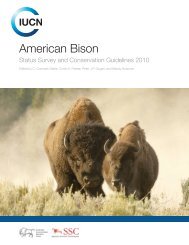Declaration Dr. Thomas H. Pringle - Buffalo Field Campaign
Declaration Dr. Thomas H. Pringle - Buffalo Field Campaign
Declaration Dr. Thomas H. Pringle - Buffalo Field Campaign
You also want an ePaper? Increase the reach of your titles
YUMPU automatically turns print PDFs into web optimized ePapers that Google loves.
Chapter 1.<br />
Introduction<br />
Conservation of wild bison (Bison bison) is crucial to conservation of North<br />
American Tribal cultures and the biodiversity of the plains ecosystem. Bison are an<br />
ecological and cultural keystone species (McHugh 1972; Erdoes and Ortiz 1984; Knapp<br />
et al. 1999). Concern for the persistence of wild bison has increased since conservation<br />
status reviews revealed that they are ecologically extinct from over 90% of their former<br />
habitats. Of the estimated >450,000 bison in the United States (U.S.), 95% of them reside<br />
on private ranches where they have been subjected to hybridization with cattle and<br />
domestication (Boyd 2003). In addition, at least seven of ten federal bison herds show<br />
evidence of hybridization (Halbert and Derr 2007).<br />
Prior to Euro-American settlement, the bison populations that roamed North<br />
America were reduced from an estimated 30 million (Seton 1937; Barsness 1985;<br />
Hornaday 2002) to less than 1000 by the late 1800’s (Coder 1975; Hornaday 2002; Smits<br />
1994). Shortly after this near extermination, the few hundred remaining bison were either<br />
captured and sent to zoos or adopted by private ranchers (Coder 1975; Hornaday 2003).<br />
The conservation efforts of the past have insured that the American bison is no longer at<br />
risk of demographic extinction. However, the loss of genetic diversity due to multiple<br />
bottlenecks, founder effects, hybridization, and domestication pose the risk of genomic<br />
extinction, and reduced evolutionary potential (Freese et al. 2007).<br />
Following Boyd’s (2003) recommendations, the Wildlife Conservation Society<br />
has initiated a comprehensive review of the status of bison in collaboration with the<br />
IUCN Bison Specialist Group. In 2005, the WCS began the revitalization of the<br />
1










